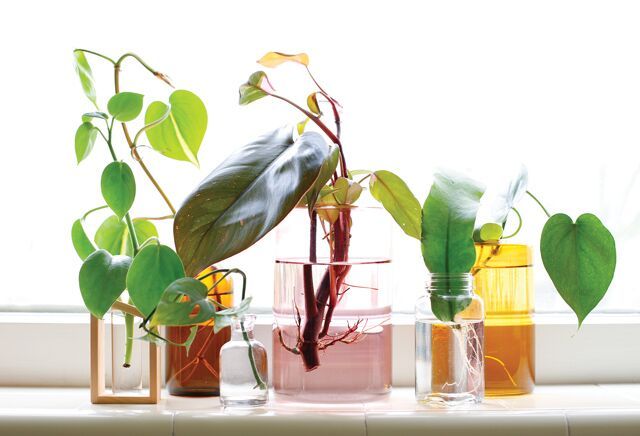With summer days in full force, your houseplants are living their best lives, which means it’s time to get propagating (i.e. growing a new plant from part of a “parent” plant). There are many ways to do this—as the owner of Folia Collective, an indoor-plant shop in Los Angeles, I’ve tried them all! But water propagation is easiest. It works for a variety of plants and allows you to see new roots as they develop.
You’ll need: plants (some of the easiest to propagate in water are Epipremnum aka pothos, Philodendron, Tradescantia aka Wandering Jew, and Scindapsus); sharp, clean pruning shears or a knife; glass vessels (amber or other opaque glass will block light and prevent algae from forming); fresh water.
1. Find a portion of your plant that is flexible enough to bend without snapping. Now find the nodes—little bumps that stick out along the vine or stem, or the area where new stems branch off from the main one. Using your shears or knife, cleanly cut off a portion of the plant that has at least two sets of nodes, just below one set—this is where new roots will form. If one set of nodes fails, you can cut just under the second set and try once more.
2. Fill your vessel with enough clean water to reach the first nodes; remove any leaves that will lie below the waterline.

3. Place vessel in an area that gets indirect light, but no direct sun. Monitor the water level to make sure the nodes are submerged. Change water once a week or so to keep bacteria at bay and ensure healthy roots.
4. Roots should form anywhere from two weeks to a few months. Check occasionally to ensure the stem doesn’t look brown or black or feel mushy—these are signs of rot. If it does rot, trim that portion, change the water, and try again. Once roots form, wait until they’re about an inch long, then move to a small pot of lightly moist soil. You can also keep your cutting in water long-term, known as “hydro culture,” letting the roots grow as long as the vessel can contain them. Just add liquid plant food occasionally to replace nutrients that would normally come from soil.
Written and photographed by Danae Horst
This article originally appeared in the July/August 2019 print edition of BUST Magazine. Subscribe today!
More from BUST
Go Green With These DIY Living Air Plant Accessories
Help The Hive, Honey: BUST’s Best Bits To Beekeeping
How To Read Tarot Cards: Advice From Tarot Readers


